Farewell, Jessica. Well, not completely . But we’re still gonna miss you: The Pulse #14
By Jeb D
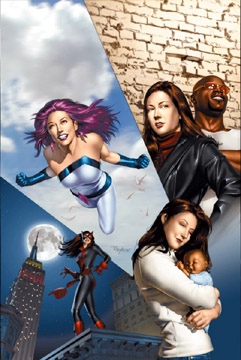 Alias heroine Jessica Jones was probably the best Marvel character introduced in the 90’s, and it’s sad to see Alias’ semi-sequel, The Pulse, come to an end.
Alias heroine Jessica Jones was probably the best Marvel character introduced in the 90’s, and it’s sad to see Alias’ semi-sequel, The Pulse, come to an end.
The “big city newspaper” setting’s an intriguing locus for telling stories of crime and superheroes, but The Pulse lacked the clear artistic vision that fueled Alias, notably with its constant shifting of artists. Though both Brent Anderson and Michael Lark contributed some nice issues, the choice to launch the series with a six-issue arc by writer Brian Bendis’ Ultimate Spider-Man collaborator Mark Bagley was a poor fit, and prevented The Pulse from really finding its footing.
As Bendis notes in the letters page this month, though, the real shame of the series’ ending is that he’d finally reunited with the Alias art team of Michael Gaydos and Matt Hollingsworth, and these last issues are bittersweet reminders of just how good Alias was.
The Pulse #14 focuses on Jessica with her new baby, talking out her decision whether or not to marry the child’s father, Luke Cage. The story gives us a look at a part of Jessica’s past we’ve not seen before, including her first meeting with Cage. It’s got the great dialog we expect from Bendis, some beautiful characterization of both Jessica and the guest characters, as well as some good old-fashioned superheroin’.
The smooth, polished cover by Mike Mayhew sums up the events of the issue nicely (and in the letters page, Bendis extols his love of several covers Mayhew has done for the series), but I’m sorry: for all that Bendis has integrated her into other books like New Avengers, Jessica Jones simply belongs to Michael Gaydos, and in her own series. Here’s hoping he gets to tell more of her stories again soon.
RATING: 
Three Issues In Proves “The Exterminators” a Must-Read
By Mark Wheaton
 What’s that saying? When Jesus shuts a door, he opens a window? Not to get blasphemous, but with the end of The Losers and Gotham Central, DC owes us one.
What’s that saying? When Jesus shuts a door, he opens a window? Not to get blasphemous, but with the end of The Losers and Gotham Central, DC owes us one.
And it’s called The Exterminators.
With an incredibly audacious beginning, The Exterminators kicked off its #1 by introducing us to the ex-con Henry James now on the straight-and-narrow working a job as an exterminator with a cast of ruffian co-workers that probably match his former block mates back in the slammer. Unfortunately, by issue #2, they’d killed off Henry’s hilariously rat-faced, pesticide-shooting partner AJ (a point seemingly borrowed from William S. Burroughs’ oeuvre – an author who blended pesticides and drugs in more than one book including his brilliant fractured novel, Exterminator), but in issue #3, they immediately replace him with the cowboy hat-wearing, philosophy spewing Stretch who turns out – on the last page – to be just as crazy and dangerous as AJ.
Oh, and Henry’s girlfriend is having a lesbian affair with her boss.
And the ever-present, hiding-in-the-background cockroaches are seen slurping up the so-called “Cockroach Kryptonite” known as Draxx that will inevitably feed into the cockroach invasion that is to come.
And the single page “shocker panel” halfway through issue #3 is just as grotesque as the ones in issue #1 (Henry gorily tearing apart the raccoon) and issue #2 (AJ’s nasty demise).
The Exterminators is just messed up – hopelessly so. Did we need to see the nebbishy Dr. Sar and the rather large Professor Neal get turned on by graphically discussing cockroach sex? Nah, but it sure works to keep the tone flowing. How about the old man who hasn’t spoken or walked since Reagan’s ’84 re-election suddenly getting naked and ecstatic to see a green-backed cockroach arrive on his window? No, but it makes for some great crazy-ass fiction that leaves the door wide open for anything to happen.
The only bad thing that can be said about The Exterminators is that with its slow-burn, it’s easy to curse the monthly-rather-than-weekly nature of comics. But if that’s how long it takes writer Simon Oliver and his perfectly matched artist Tony Moore to deliver this killer book chock full of surprises, so be it.
RATING: 
Screaming rocket monkeys! Sky Ape returns in King Of Girls
By Graig
 To read Sky Ape is to know Sky Ape. To know Sky Ape is to love Sky Ape. And if you already love Sky Ape, I don’t need to sell you King of Girls any further. But what if you’ve been living in a comic-less hovel for the past ten years? Or what if your comic shop only stocks “Big Two” and “boob war” books (and, no, I’m not being redundant, the “Big Two” here refer to Marvel and DC and not breasts)? How do I explain Sky Ape to you, the intrigued consumer? Five words: monkey with a jet pack.
To read Sky Ape is to know Sky Ape. To know Sky Ape is to love Sky Ape. And if you already love Sky Ape, I don’t need to sell you King of Girls any further. But what if you’ve been living in a comic-less hovel for the past ten years? Or what if your comic shop only stocks “Big Two” and “boob war” books (and, no, I’m not being redundant, the “Big Two” here refer to Marvel and DC and not breasts)? How do I explain Sky Ape to you, the intrigued consumer? Five words: monkey with a jet pack.
The original mini-series featuring the eponymous gorilla appeared nearly a decade ago from Slave Labor, years later mercifully reprinted in trade format by AIT/PlanetLar, which was popular enough to warrant two subsequent extra-sized specials. Though the first series was almost equal parts comedy, action-adventure, and character drama, as writers Phil Amara and Tim McCarney (along with Mike Russo) revisited the titular character and his posse, they let the characterization fall to the wayside and let the comedy take hold. Even the action sequences became just another accentuation point to the comedy. With King of Girls, the third and latest Sky Ape book disposes of the action-adventure elements and is, quite literally, a straight-out comedy.
In the story, the character that takes the subtitle, the King of Girls, is transforming socially inept men into an army of well-groomed Casanovas and it’s up to Sky Ape and his rag-tag group of non-heroes (including Paper Bob, Mister The Fake Lion and the inept superteam Victory’s Thirteen) stop him… for reasons which seem to make sense only to them. There’s no real threat, no real action and almost no purpose to the story, except that it’s so bizarrely absurd that it must be told. It’s like if Hellboy merged with Flaming Carrot and The Tick, only the Flaming Helltick was a bit of a pacifist. Seriously, the King Of Girls should have a “Special Non-violent Issue” button on the cover, and though the pacing is rather odd, especially compared to previous Sky Ape adventures, it all works. Artist Richard Jenkins has switched up his style since previous adventures to such an extreme that I had thought it a different artist. Here he uses a clean, cartoony Batman Adventures-style, which works for the humorous tone of the book, but I liked his older, busier, more rendered style better.
Fret not if you’re unfamiliar with the rocket gorilla, King of Girls is a stand-alone tale which really requires no knowledge of the characters in order to enjoy the blissfully trippy, pop-culture infused ride.
RATING: 
Steven Seagle and Becky Cloonan Fumble with Ecstasy in “American Virgin”
By Russell Paulette
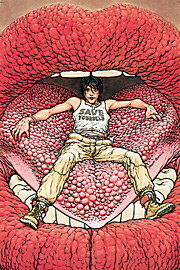 This isn’t my first time, you know. Steven Seagle’s an old hand at this, too―American Virgin marks his third attempt at a new Vertigo ongoing series. Demo was Becky Cloonan’s main claim-to-fame, so she’s not exactly baby-fresh, either. Being a big fan of Vertigo, I often find myself drawn to their new launches, dipping in and out of brand-new ongoing series, watching as some skyrocket, a la 100 Bullets or Y The Last Man, and others fade into obscurity. Outlaw Nation, anyone? How’s about American Century? Seekers into the Mystery? That said, Seagle and Cloonan’s past work had me riding a particular high for this new launch, and with last week’s offering of the first issue, how did my expectations pay off?
This isn’t my first time, you know. Steven Seagle’s an old hand at this, too―American Virgin marks his third attempt at a new Vertigo ongoing series. Demo was Becky Cloonan’s main claim-to-fame, so she’s not exactly baby-fresh, either. Being a big fan of Vertigo, I often find myself drawn to their new launches, dipping in and out of brand-new ongoing series, watching as some skyrocket, a la 100 Bullets or Y The Last Man, and others fade into obscurity. Outlaw Nation, anyone? How’s about American Century? Seekers into the Mystery? That said, Seagle and Cloonan’s past work had me riding a particular high for this new launch, and with last week’s offering of the first issue, how did my expectations pay off?
To begin with, the premise is simple. Adam Chamberlain is a strict Christian who has parlayed his theology degree and chaste self-image into a media marketing campaign. Attending hip-to-trot college campus venues, he peddles his saving-it message with a sincere, honest belief that his virginity is not something to be taken lightly. Slowly, as the first issue unfolds, Seagle presents an earnest veneer in Adam―here’s a guy, despite his biological impulses, who is trying to practice what he literally preaches. Hypocrisy surrounds the kid, though, in the form of an overbearing mother and a media-mogul stepdad with dollar-signs in his eyes; a brother who indulges in sins of the flesh just out of reach of their parents; a pair of cousins who go to extreme lengths to make their point to Adam; and a saintly girlfriend, half a world away, as desperate to give into her urges as Adam is to give into his. All of this is presented with a straightforward sincerity on Seagle’s part, honestly pursuing the logic and reasoning of Adam’s character. All the issues, then, come to a crashing halt with the devastating revelation at the end, an even that will, no doubt, serve as the inciting event for this entire series, and one that is reason enough for Adam to start on the questioning quest that this series is destined to become.
Artwise, Cloonan is adapting very well to the switch from pure black-and-white to color work. Aided by colorist, Brian Miller, Cloonan exhibits the same stortyelling chops she showed on Demo, while at the same time expanding her range by loosening her spot blacks and allowing Miller to do his work when necessary. Added to it, Cloonan seems to have taken a cue from Paul Pope in some of her storytelling quirks and rendering―never enough to feel derivative, but just enough to feel like the barest homage. Clear, simple, graceful, straightforward storytelling is the name of the game, here, and Cloonan is scoring major points.
If I had to fault the issue anything, it’s that the revelation at the end―the major storytelling event―really kicks things into gear. Before that, the characterization felt more in service to that moment than anything else. That said, the sketchy renderings of the different people in Adam’s life will only deepen once we join him on his quest. Until then, the first movement is reason enough to expect big things from this series that will, hopefully, go down in the annals of classic Vertigo, rather than the also-rans.
RATING: 
Sometimes Armageddon Is Just In Time
by Elgin Carver
 On occasion, disparate items are blended into an amalgam that is at the same time familiar and entirely different. Tom Strong read like the pulp heroes of the 1930s and ‘the most modern of scientific geniuses; like the comics of the 1960s and the best of these years’ science fiction novels. The covers mimic action covers from every genre and the stories are as innovative (if derived from many, many old concepts). Few books have attracted me as much as the first fifteen or twenty issues. Eventually the steam began to run low and the pace lagged. I kept reading every issue but with diminished enjoyment.I wondered if the spark that began so brightly but then dimmed could be brought back to life. Well, it could, but only to say good-bye.
On occasion, disparate items are blended into an amalgam that is at the same time familiar and entirely different. Tom Strong read like the pulp heroes of the 1930s and ‘the most modern of scientific geniuses; like the comics of the 1960s and the best of these years’ science fiction novels. The covers mimic action covers from every genre and the stories are as innovative (if derived from many, many old concepts). Few books have attracted me as much as the first fifteen or twenty issues. Eventually the steam began to run low and the pace lagged. I kept reading every issue but with diminished enjoyment.I wondered if the spark that began so brightly but then dimmed could be brought back to life. Well, it could, but only to say good-bye.
An almost lyrical story of the end of the world, that falters only because of a kind of self- conscious use of language, unites virtually every character important to this series in a lovely little tie up that is surprisingly satisfying. Would that every writer could rise to this level when the time comes to complete a story. Like chess, the end game tells the tale, and this is no exception. Only The Sandman Mystery Theatre did it nearly as well.
If you ever enjoyed this series, you owe it to yourself to pick up issue #36. If you have never read it go to the local comic shop and pick up every issue they have,then enjoy a nice spring day under your favorite tree, immersed in goodness, and a fond farewell.
RATING: 
Mister Miracle Ends Back Where It Begins
By Chris B.
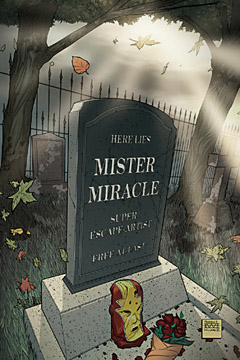 Ask a few people what their favorite Seven Soldiers title is. None of them will agree: Frankenstein, Klarion, Shining Knight, Manhattan Guardian, hell, even Bulleteer will come up. But nobody on the face of the earth will tell you that Mister Miracle is the best part of Grant Morrison’s rambling, violent excavation of DC mythology.
Ask a few people what their favorite Seven Soldiers title is. None of them will agree: Frankenstein, Klarion, Shining Knight, Manhattan Guardian, hell, even Bulleteer will come up. But nobody on the face of the earth will tell you that Mister Miracle is the best part of Grant Morrison’s rambling, violent excavation of DC mythology.
For one thing, none of the rest of it is quite as rambling as Miracle manages to be. It follows Shilo Norman (Mister Miracle II) as he discovers that the New Gods are hiding on earth as a crowd of homeless people, then has his life ruined by Darkseid. Unless I’m missing something, the only tie-in to the larger Soldiers story here is some half-assed rambling thrown in the middle of issue #4 that briefly mentions the Sheeda.
This final issue is confusing enough to be spoiler-proof, so I doubt I’ll be able to give it away if I try. The strongest parts of the issue are easily the flashbacks to
Finally Metron – New God Metron, not homeless Metron – shows up and tells Miracle that he has passed some New God initiation.
The art (by Freddie Williams II) is hard to get excited about, compared to the exhilarating work J.H. Williams III, Simone Bianchi, and Doug Mahnke have done on other Soldiers books, where every page is crowded with detail and style. The kindest thing to say about the art on Miracle #4 is that it’s clean; more accurately, it’s plain and generic. (I have to admit that Williams’s cover for the issue is great, though. Who isn’t a sucker for good tombstone inscriptions?)
Morrison’s writing here recalls all the worst parts of The Invisibles, where he just slings ideas at the page without bothering to see if they stick, or even connect. The preview copy for Mister Miracle reads better than the issues themselves – Man-eating cars of Apokolips! The most shocking conclusion you will see in a comic this year! The Final Escape! Somehow, those one-paragraph pitches never worked out when stretched into stories of their own.
It would be nice to say the title improved as it went along, that Miracle was just building up steam in those dull early issues. But it never starts working. It doesn’t go anywhere.
RATING: 
Big events in the small lives of birds: Big Questions 8
By Graig
 One of my favourite things about being an avid comics reader is the process of discovery, of picking up an issue of a title that I’ve never heard of before and watching the magic unfold before me with each turn of the page. Even a truly horrible book still elicits a sense of freshness if it’s completely new to me, but it’s even more exciting if the book is actually good. Big Questions 8 from Drawn & Quarterly is not just good, but beautiful as well. You can experience the marvel of discovery yourself by skipping over this review and going out and getting your own copy, but if you need more of a push, I’ll expand.
One of my favourite things about being an avid comics reader is the process of discovery, of picking up an issue of a title that I’ve never heard of before and watching the magic unfold before me with each turn of the page. Even a truly horrible book still elicits a sense of freshness if it’s completely new to me, but it’s even more exciting if the book is actually good. Big Questions 8 from Drawn & Quarterly is not just good, but beautiful as well. You can experience the marvel of discovery yourself by skipping over this review and going out and getting your own copy, but if you need more of a push, I’ll expand.
Even though this is the eighth book in the series, which has apparently been slowly unfolding over the past few years, it’s not essential to have read the previous books to get seriously wrapped up in the story. The front and back cover fold-ins present a brief character-by-character bio that bring you up to speed on who the players are and what has gone on. In a soap operatic fashion, the book follows the lives of a community of birds following a big event in their lives. A giant metal bird (a plane) crashed in the field near the community. The community decided to watch over the dead giant’s “eggs”, only to have them explode. One character, Betty, is haunted by the ghosts of those that died in the explosion, while another, Algernon, is lost in a snake hole, having a strange arrangement with the hole’s mysterious and eclectic occupant. The plane’s pilot is delusional and lost roaming the woods. The Idiot is also roaming free, his home and grandmother both destroyed when one of the plane’s engines crashed into their cottage.
The depth of character in this book is astounding, to the point that even though visually the various birds are indistinguishable from one another, their personalities shine through in the dialogue. There’s a very deliberate and methodical pace to the story: it’s tranquil but engrossing, beautiful and slightly haunting. Creator Anders Nilson has made something extraordinary with Big Questions, a story that uses animals as primary characters, but keeps them in a natural environment. You never get a sense that these are anthropomorphic animals, acting as allegory to human situations or human characteristics, but instead if feels as if as reader you’re being let in on the inner workings of nature. It’s more grounded than cartoons like Watership Down and has a sense of honesty to it. Nilson’s artwork is equally at times excessively simplistic and densely complex. He uses clean simple lines, and his attention to white space makes this one of the most eye catching black and white books I’ve read in a long time.
Having already reread Big Questions 8 three times, I know I’m hooked on the story and will be seeking out previous issues while anxiously anticipating the next. Nilson as well has made a huge impact, and his other works are definitely on my “to buy” list. Highly recommended.
RATING: 
Outlaws May Need Love. But You Don’t Have to Love Them Back
by
 Marvel’s one shot Outlaw Love appears to be aimed at whatever pitifully small percentage of the comic reader population is female. Soft colors depicting a reclining female figure being watched over by an overly large, vaguely transparent figure of Bullseye, says to me "Come on girls, give me a try."
Marvel’s one shot Outlaw Love appears to be aimed at whatever pitifully small percentage of the comic reader population is female. Soft colors depicting a reclining female figure being watched over by an overly large, vaguely transparent figure of Bullseye, says to me "Come on girls, give me a try."
I’m all for that. In the 1940s and 1950s, like the population in general, the reading population of comics was more female than male. The reading population was spread from the earliest reading age, concentrating in the 10 to 15 year old range, and spreading in diminishing numbers to the mid twenty’s. Today few readers start before the early teens and their numbers are concentrated in the mid-twenty’s with very few thirty and above. Books selling 25,000 copies a month are considered doing OK, while The Doom Patrol’s first series was brought to a halt when sales dropped to 250,000, and major titles sold ten times that number. If the industry was a an emergency room patient I would be yelling "Charge! Clear!" over and over as I tried to shock it back to life.
Books that attempt to enlarge the audience deserve a fair shot, and I want to give it to them. However this disaster won’t do it. If its aimed at men, it needs a different cover. If it is aimed at women, it needs a different interior. If it is aimed at younger readers, it needs a different story. Confused and generally pointless, it follows a sort of eternal triangle between (for my money) tertiary characters. The possibilities were there, complex emotions from odd ball people in strange circumstances, yet with relationships we could all relate to; that was what it could have been. This was a complete disappointment.
RATING: 
Slow-Burning “Down” Takes Major Turn
By Mark Wheaton
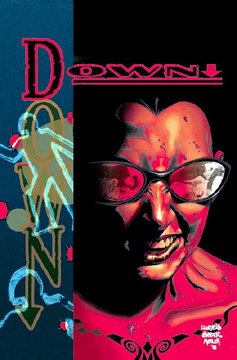 “I don’t know if I’m still a cop.”
“I don’t know if I’m still a cop.”
Warren Ellis can do no wrong. Should you find yourself reading a Warren Ellis comic and questioning this (hey, it can happen to anybody), repeat the first sentence. Then go read Ocean or The Ministry of Space.
Or Down.
When people talk about Warren Ellis these days, it seems to focus on the delightfully minimalist Fell, the just-damn-brilliant-and-hilarious Next Wave or the heir-apparent-to-Transmetropolitan, Desolation Jones, so the undercover cop crime drama Down almost feels like an after-thought – one of those Ellis series that doesn’t get the ink, so may not be worth the time. But it is and issue #4 should silence any doubters.
Deanna Ransome’s a cop sent into deep cover who, in the course of trying to get an “in,” has to kill a lot of people – good and bad. With issue #4, this only increases – going from shooting dirty cops in issue #3 to prove a point to simply shooting on-duty cops in issue #4 just because they recognize her – though there are no underworld hoods around to impress. She then gets involved in a serious gun battle that ingratiates her to Nick, another bigtime gangster.
Who she promptly shoots in the head for raping his date.
And then shoots his bodyguards.
And then shoots her handler in the police department who sent her down this road in the first place – the only one who knows of her mission.
By the end of the issue, she’s killed eight people (including one she crushes with a squad car) – three cops, one crime-lord, two bodyguards and a couple of street hoods just trying to fuck shit up. And on the final page, she announces her intentions: to engulf the entire underworld – and by extension, the corrupt cops – in a massive gang war that wipes out the criminal element in the city once and for all.
Ellis’s recent books Jack Cross, Red and Re-Load took their anti-authoritarian swipes at the government and their spy agencies. What’s different about Down is its focus on crime and the police, something Ellis is certainly familiar with in his writing, but in a way that puts it in direct opposition to the quiet lead detective of Fell, the one good man in a hellish town of realistic crime trying to make things right by following the straight-and-narrow, something he really goes for in this week’s issue #4. Deanna Ransome doesn’t have that problem of conscience weighing her down.
Time and time again, Ellis proves that he is one of the elite – the Ray Bradbury of comic book writers – and Down is no exception. If you haven’t been keeping up, an eventual TPB might be the best way to go, but after issue #4, it’s getting harder to make that argument.
RATING: 
Arbeit Macht Frei — X Men: The 198 issue # 3 of 5
by Elgin Carver
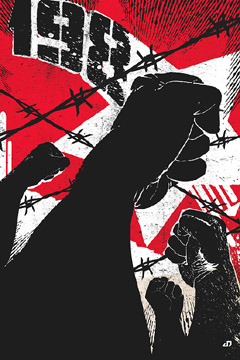 For quite some time the X Men titles have collectively worked to compare mutants with either Jews, African-Americans, or homosexuals depending on your point of view and/or background. The idea that persons who differ from the norm and are met with ostracism at best, and violence at worst, has been handled with varying levels of ability. The hand in The 198 is fairly heavy and with enough weight to push a lot of the interest out of the idea. In a world not only being taken over by a population explosion of mutants, but through a number of horrible incidents, the millions of special people have been reduced to the title’s total. As this reduced number is rounded up and incarcerated "for their protection" at Professor Xavier’s mansion, the personalities of those being held are tried and seldom found wanting.
For quite some time the X Men titles have collectively worked to compare mutants with either Jews, African-Americans, or homosexuals depending on your point of view and/or background. The idea that persons who differ from the norm and are met with ostracism at best, and violence at worst, has been handled with varying levels of ability. The hand in The 198 is fairly heavy and with enough weight to push a lot of the interest out of the idea. In a world not only being taken over by a population explosion of mutants, but through a number of horrible incidents, the millions of special people have been reduced to the title’s total. As this reduced number is rounded up and incarcerated "for their protection" at Professor Xavier’s mansion, the personalities of those being held are tried and seldom found wanting.
Therein lies the problem with the series to this point. The non-mutant humans are universally contemptible, while the mutants, regardless of their past lives, or even present actions, are either sanctified or their actions are portrayed as excusable or understandable. Perhaps this will change. Perhaps some complexity will be added. Let us hope so. The last few years of the "X" titles have been generally interesting. The growth and then reduction of the mutant population was reasonably well handled, with the same caveat that The 198 carries. However that warning carries a fault that is not inconsiderable. Everyone carries within themselves the capability for both good and evil, and virtually everyone demonstrates both these assets/liabilities on a daily basis. It is the strife within that makes tensions in stories and characterizations interesting.
This is a perfect example of a title that screams out to be released as a graphic novel. Why must a short story be dragged out through nearly half a year? Why cannot the work be a complete work prior to issuance? Until comic publishers face up to their readers and critics with difficult themes told in an intellectually complex manner, with sufficient depth so as to complete a thought, their product will continue to be viewed (and rightly so) as a second class artform with a shrinking audience.
RATING: 
![]()

Rocketo: Journey to the Hidden Sea TPB Vol. 1
(Image)
By Rob Glenn
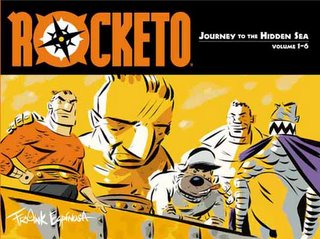 The reason adventure stories are usually period pieces is because we have lost our "here there be dragons" acceptance of the unknown. We live in a world where anyone in the private sector can rent a satellite long enough to take pictures of anywhere on the surface of the earth. We wouldn’t accept King Kong in a modern setting because we would never believe there was an island out there large enough to house giant apes and dinosaurs without our knowing about it. This is why the world of Rocketo is in the distant future. This is a world where the continents have been shattered and reconfigured. A world where the magnetic poles are nonexistent. Without fixed points for a compass to focus on, genetically improved people called Mappers are used to navigate this strange, fantastic world.
The reason adventure stories are usually period pieces is because we have lost our "here there be dragons" acceptance of the unknown. We live in a world where anyone in the private sector can rent a satellite long enough to take pictures of anywhere on the surface of the earth. We wouldn’t accept King Kong in a modern setting because we would never believe there was an island out there large enough to house giant apes and dinosaurs without our knowing about it. This is why the world of Rocketo is in the distant future. This is a world where the continents have been shattered and reconfigured. A world where the magnetic poles are nonexistent. Without fixed points for a compass to focus on, genetically improved people called Mappers are used to navigate this strange, fantastic world.
Frank Espinosa’s book was originally with the now defunct Speakeasy Comics. Luckily for us, Image Comics picked up the mantle to continue this series. Collected here is the first half of the "Journey to the Sea" arc and includes issue 0 which was distributed at the last Sand Diego Comic Con. Espinosa’s art is honed from years of working with other companies’ characters in their consumer product’s division. Rocketo shows how he instinctively knows how few lines are required to convey action or character. This minimalist approa